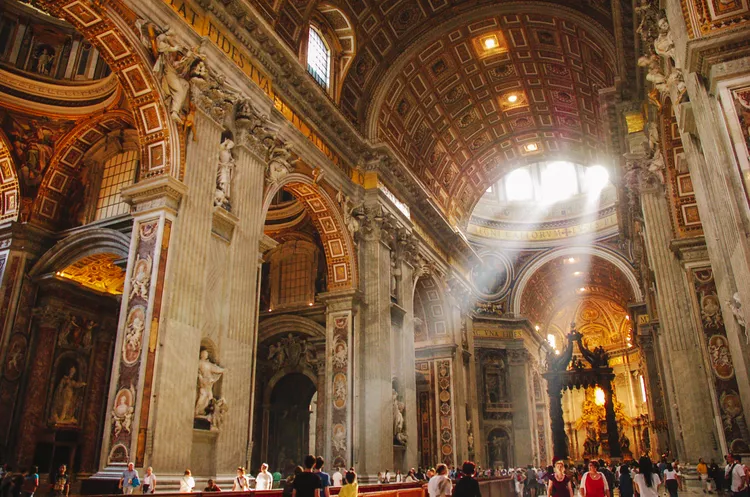Summary
What to See and Do in Vatican City
Vatican City, also called the Holy See, is a tiny sovereign independent state. Vatican City covers only .44 sq. km. and has a population of fewer than 1000. Vatican City gained independence from Italy on February 11, 1929. Over five million people visit Vatican City each year to explore its remarkable history and culture.
The Holy See serves as the seat of the Catholic religion and has been home to the Pope since 1378. The Pope resides in the papal apartments located within Vatican City, and St. Peter’s Basilica is a significant landmark in this area.
Vatican City Location
Vatican City is completely encircled by Rome. Visitors can access Vatican City through St. Peter’s Square. The most convenient route from historic Rome involves crossing the Ponte St. Angelo bridge. Upon reaching the other side, visitors encounter Castel St. Angelo, positioned just outside Vatican City. This historic castle features a connecting passage that was once an escape route for popes in times of danger.
Where to Stay Near Vatican City
If you plan to spend significant time exploring Vatican City’s attractions, staying in a nearby hotel or bed and breakfast can enhance your experience. Selecting accommodations close to the Vatican allows you more time to immerse yourself in its rich heritage.
Vatican Museums
The Vatican Museums represent the largest museum complex in the world, boasting over 1,400 rooms. This expansive complex includes an array of galleries featuring 3,000 years of art, the Sistine Chapel, and sections of the papal palace. Visitors will discover an impressive collection of works, including a dedicated room of masterpieces by Raphael. One highlight is the Pinacoteca Vaticana, recognized as Rome’s premier picture gallery hosting numerous Renaissance artworks. Additionally, the Hall of Maps captivates visitors with its stunning murals that depict ancient maps of the papal territories.
Visiting the Vatican Museums
While at the Vatican Museums, guests can choose from four different itineraries, all culminating at the Sistine Chapel. Given the museum’s vastness, opting for a guided tour is advisable, allowing for a more enriching experience. Visitors who secure guided tour reservations or purchase tickets in advance can bypass long waiting lines. Please note that the museums are closed on Sundays and holidays; however, they offer free admission on the last Sunday of each month.
Sistine Chapel
The exquisite Sistine Chapel was constructed between 1473 and 1481, serving as both the pope’s private chapel and the site for papal elections conducted by the cardinals. The chapel is famous for its breathtaking ceiling frescoes painted by Michelangelo, vividly illustrating scenes from creation and the story of Noah. Various other biblical scenes around the chapel were created by renowned artists including Perugino and Botticelli.

Saint Peter’s Square and Basilica
Saint Peter’s Basilica, erected on the site of a church that once covered Peter’s tomb, stands as one of the largest churches globally. While entry to the basilica is free, visitors are required to adhere to a dress code, prohibiting bare knees and shoulders. The basilica welcomes guests daily from 7 a.m. to 7 p.m. (until 6 p.m. from October to March). Masses are held throughout the day on Sundays in Italian.
Saint Peter’s Basilica is situated within Saint Peter’s Square, a prominent religious and tourist hub. Visitors can appreciate significant artworks, including Michelangelo’s acclaimed Pieta, and even visit the Pope’s tombs.
Vatican City Transportation and Tourist Information
Vatican City Tourist Information is conveniently located on the left side of St. Peter’s Square, offering valuable resources as well as a small shop that sells maps, guides, souvenirs, and jewelry. The tourist information center operates Monday through Saturday from 8:30 a.m. to 6:30 p.m.
The closest Metro station to the museum entrance is Cipro-Musei Vaticani. This station is near Piazza Santa Maria delle Grazie, where a parking garage is also available. Bus 49 and tram 19 provide public transport access nearby. Various bus routes also service areas close to Vatican City.
The Swiss Guard
The Swiss Guard has protected Vatican City since 1506 and continues to don their traditional costumes today. To qualify as a guard, recruits must be Roman Catholic Swiss nationals, aged 19 to 30, unmarried, high school graduates, and a minimum height of 174 cm. Recruits must also have completed Swiss military service.
Castel Sant Angelo
Castel Sant Angelo, located along the Tiber River, was originally constructed as a tomb for Emperor Hadrian in the second century. During the Middle Ages, it served as a fortress and later became a papal residence in the 14th century. The structure sits atop Roman walls and boasts an underground passageway that extends to the Vatican. Visitors are welcome to explore Castel Sant Angelo, and in summer, concerts and special events are held within its grounds. The area is pedestrian-friendly, making it a pleasant spot for leisurely strolls along the river.





